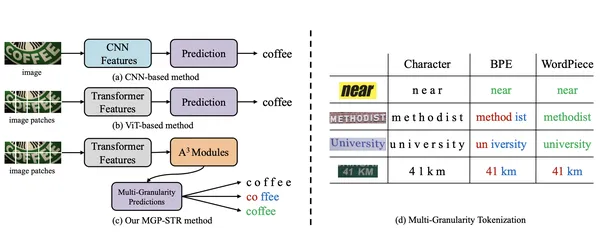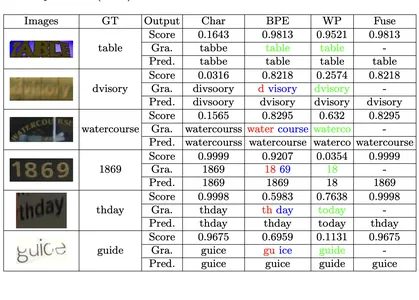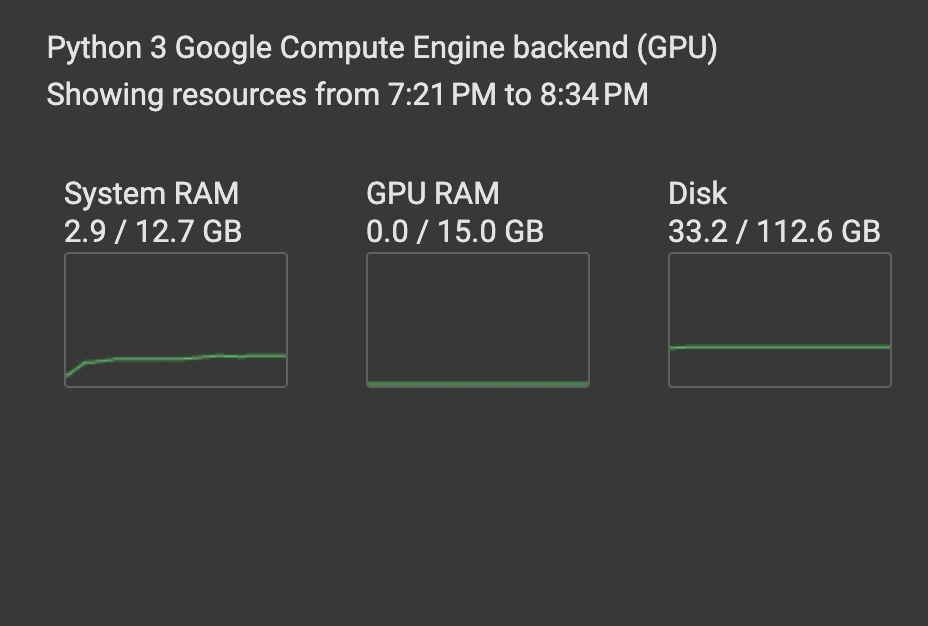Scene Text Recognition Using Vision-Based Text Recognition
Scene Text Recognition (STR) remains a significant challenge for researchers due to the wide variety of text appearances in real-world settings. Recognizing text on a document is different from identifying text on a t-shirt, for instance. The Multi-Granularity Prediction for Scene Text Recognition (MGP-STR) model, introduced at ECCV 2022, offers a groundbreaking approach. MGP-STR combines the robustness of Vision Transformers (ViT) with innovative multi-granularity linguistic predictions, significantly improving its ability to handle complex STR tasks. This results in higher accuracy and better usability across diverse, challenging real-world scenarios, providing a simple yet powerful solution.
Key Learning Points
- Grasp the architecture and components of MGP-STR, including Vision Transformers (ViT).
- Understand how multi-granularity predictions boost the accuracy and adaptability of scene text recognition.
- Explore the practical applications of MGP-STR in real-world Optical Character Recognition (OCR) tasks.
- Gain practical experience implementing and using MGP-STR with PyTorch for scene text recognition.
*This article is part of the***Data Science Blogathon.
Table of contents
- What is MGP-STR?
- Applications and Use Cases of MGP-STR
- Getting Started with MGP-STR
- Step 1: Importing Dependencies
- Step 2: Loading the Base Model
- Step 3: Helper Function for Text Prediction from Images
- Conclusion
- Frequently Asked Questions
What is MGP-STR?
MGP-STR is a vision-based STR model excelling without needing a separate language model. It integrates linguistic information directly into its architecture using the Multi-Granularity Prediction (MGP) strategy. This implicit approach allows MGP-STR to outperform both purely visual models and language-enhanced methods, achieving state-of-the-art STR results.
The architecture consists of two key components:
- Vision Transformer (ViT)
- A³ Modules
The fusion of predictions at character, subword, and word levels through a simple yet effective strategy ensures MGP-STR captures both visual and linguistic details.

Applications and Use Cases of MGP-STR
MGP-STR is primarily for OCR tasks on text images. Its unique ability to implicitly incorporate linguistic knowledge makes it particularly useful in real-world scenarios with varied and distorted text. Examples include:
- Reading text from natural scenes (street signs, billboards).
- Extracting text from scanned forms and documents (handwritten or printed).
- Analyzing text in industrial settings (product labels, barcodes).
- Text translation/transcription in augmented reality (AR) applications.
- Information extraction from scanned documents or photos of printed materials.
- Assisting accessibility solutions (screen readers).

Key Features and Benefits
- No Need for Independent Language Models
- Multi-Granularity Predictions
- State-of-the-Art Performance
- User-Friendly
Getting Started with MGP-STR
This section shows how to use MGP-STR for scene text recognition on a sample image. You'll need PyTorch, the Transformers library, and dependencies (PIL, requests).
Step 1: Importing Necessary Libraries
Import the required libraries: transformers for model handling, PIL for image manipulation, and requests for fetching online images.
<code>from transformers import MgpstrProcessor, MgpstrForSceneTextRecognition import requests import base64 from io import BytesIO from PIL import Image from IPython.display import display, Image as IPImage</code>
Step 2: Loading the Pre-trained Model
Load the MGP-STR base model and its processor from Hugging Face Transformers.
<code>processor = MgpstrProcessor.from_pretrained('alibaba-damo/mgp-str-base')
model = MgpstrForSceneTextRecognition.from_pretrained('alibaba-damo/mgp-str-base')</code>Step 3: Image Processing and Text Prediction Function
Create a function to input image URLs, process them using MGP-STR, and return text predictions. This handles image conversion, base64 encoding, and text decoding.
<code>def predict(url):
image = Image.open(requests.get(url, stream=True).raw).convert("RGB")
pixel_values = processor(images=image, return_tensors="pt").pixel_values
outputs = model(pixel_values)
generated_text = processor.batch_decode(outputs.logits)['generated_text']
buffered = BytesIO()
image.save(buffered, format="PNG")
image_base64 = base64.b64encode(buffered.getvalue()).decode("utf-8")
display(IPImage(data=base64.b64decode(image_base64)))
print("\n\n")
return generated_text</code>Examples (using image URLs from the original text):
The examples with image URLs and predictions are omitted here to save space, but they would follow the same structure as in the original text, calling the predict function with different image URLs.
The model's accuracy is evident from the image examples. Its efficiency is noteworthy, running on a CPU with low RAM usage. This makes it easily adaptable for fine-tuning on domain-specific tasks.

Conclusion
MGP-STR effectively combines vision and language understanding. Its innovative multi-granularity predictions provide a comprehensive approach to STR, improving accuracy and adaptability without external language models. Its simple yet accurate architecture makes it a valuable tool for researchers and developers in OCR and STR. Its open-source nature promotes further advancements in the field.
Resources
- Google Collab: [Link] (Replace with actual link)
- Arxiv: [Link] (Replace with actual link)
- GitHub: [Link] (Replace with actual link)
- HuggingFace: [Link] (Replace with actual link)
Key Points
- MGP-STR integrates vision and language without separate language models.
- Multi-granularity predictions enhance its performance across diverse challenges.
- MGP-STR achieves state-of-the-art results with a simple architecture.
- It's easily adaptable for various OCR tasks.
Frequently Asked Questions
-
Q1: What is MGP-STR and how does it differ from traditional STR models? A1: MGP-STR integrates linguistic predictions directly into its vision-based framework using MGP, eliminating the need for separate language models found in traditional methods.
-
Q2: What datasets were used to train MGP-STR? A2: The base model was trained on MJSynth and SynthText.
-
Q3: Can MGP-STR handle distorted or low-quality text images? A3: Yes, its multi-granularity prediction mechanism allows it to handle such challenges.
-
Q4: Is MGP-STR suitable for languages other than English? A4: While optimized for English, it can be adapted to other languages with appropriate training data.
-
Q5: How does the A³ module contribute to MGP-STR’s performance? A5: The A³ module refines ViT outputs, enabling subword-level predictions and embedding linguistic information.
Note: The image placeholders remain the same as in the original input. Remember to replace the bracketed links with actual links.
The above is the detailed content of Scene Text Recognition Using Vision-Based Text Recognition. For more information, please follow other related articles on the PHP Chinese website!

Hot AI Tools

Undresser.AI Undress
AI-powered app for creating realistic nude photos

AI Clothes Remover
Online AI tool for removing clothes from photos.

Undress AI Tool
Undress images for free

Clothoff.io
AI clothes remover

Video Face Swap
Swap faces in any video effortlessly with our completely free AI face swap tool!

Hot Article

Hot Tools

Notepad++7.3.1
Easy-to-use and free code editor

SublimeText3 Chinese version
Chinese version, very easy to use

Zend Studio 13.0.1
Powerful PHP integrated development environment

Dreamweaver CS6
Visual web development tools

SublimeText3 Mac version
God-level code editing software (SublimeText3)

Hot Topics
 1676
1676
 14
14
 1429
1429
 52
52
 1333
1333
 25
25
 1278
1278
 29
29
 1257
1257
 24
24
 How to Build MultiModal AI Agents Using Agno Framework?
Apr 23, 2025 am 11:30 AM
How to Build MultiModal AI Agents Using Agno Framework?
Apr 23, 2025 am 11:30 AM
While working on Agentic AI, developers often find themselves navigating the trade-offs between speed, flexibility, and resource efficiency. I have been exploring the Agentic AI framework and came across Agno (earlier it was Phi-
 OpenAI Shifts Focus With GPT-4.1, Prioritizes Coding And Cost Efficiency
Apr 16, 2025 am 11:37 AM
OpenAI Shifts Focus With GPT-4.1, Prioritizes Coding And Cost Efficiency
Apr 16, 2025 am 11:37 AM
The release includes three distinct models, GPT-4.1, GPT-4.1 mini and GPT-4.1 nano, signaling a move toward task-specific optimizations within the large language model landscape. These models are not immediately replacing user-facing interfaces like
 How to Add a Column in SQL? - Analytics Vidhya
Apr 17, 2025 am 11:43 AM
How to Add a Column in SQL? - Analytics Vidhya
Apr 17, 2025 am 11:43 AM
SQL's ALTER TABLE Statement: Dynamically Adding Columns to Your Database In data management, SQL's adaptability is crucial. Need to adjust your database structure on the fly? The ALTER TABLE statement is your solution. This guide details adding colu
 Rocket Launch Simulation and Analysis using RocketPy - Analytics Vidhya
Apr 19, 2025 am 11:12 AM
Rocket Launch Simulation and Analysis using RocketPy - Analytics Vidhya
Apr 19, 2025 am 11:12 AM
Simulate Rocket Launches with RocketPy: A Comprehensive Guide This article guides you through simulating high-power rocket launches using RocketPy, a powerful Python library. We'll cover everything from defining rocket components to analyzing simula
 DeepCoder-14B: The Open-source Competition to o3-mini and o1
Apr 26, 2025 am 09:07 AM
DeepCoder-14B: The Open-source Competition to o3-mini and o1
Apr 26, 2025 am 09:07 AM
In a significant development for the AI community, Agentica and Together AI have released an open-source AI coding model named DeepCoder-14B. Offering code generation capabilities on par with closed-source competitors like OpenAI
 The Prompt: ChatGPT Generates Fake Passports
Apr 16, 2025 am 11:35 AM
The Prompt: ChatGPT Generates Fake Passports
Apr 16, 2025 am 11:35 AM
Chip giant Nvidia said on Monday it will start manufacturing AI supercomputers— machines that can process copious amounts of data and run complex algorithms— entirely within the U.S. for the first time. The announcement comes after President Trump si
 Runway AI's Gen-4: How Can AI Montage Go Beyond Absurdity
Apr 16, 2025 am 11:45 AM
Runway AI's Gen-4: How Can AI Montage Go Beyond Absurdity
Apr 16, 2025 am 11:45 AM
The film industry, alongside all creative sectors, from digital marketing to social media, stands at a technological crossroad. As artificial intelligence begins to reshape every aspect of visual storytelling and change the landscape of entertainment
 Guy Peri Helps Flavor McCormick's Future Through Data Transformation
Apr 19, 2025 am 11:35 AM
Guy Peri Helps Flavor McCormick's Future Through Data Transformation
Apr 19, 2025 am 11:35 AM
Guy Peri is McCormick’s Chief Information and Digital Officer. Though only seven months into his role, Peri is rapidly advancing a comprehensive transformation of the company’s digital capabilities. His career-long focus on data and analytics informs




